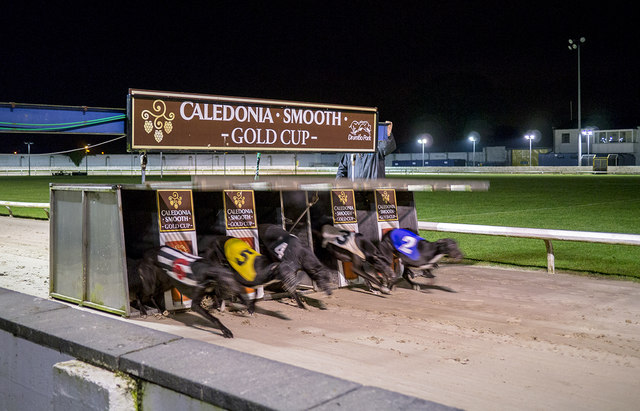Greyhound racing is a competitive sport in which greyhounds race around a track to determine the fastest dog. There are two types of races for greyhounds to compete in, depending on their ability: graded events and open events.
Graded Events
Graded events are races where six dogs of equal ability are pitched against each other. This ensures an evenly matched race. Typically, factors to determine a dog’s grade include:
- Trial times: A dog’s performance in trial runs helps to assess its ability.
- Past race performances: Racing managers use each greyhound’s racing history to determine its grade.
- Injury history: Greyhounds with past injuries may be placed in separate grades, depending on their current fitness.
Open Events
Open events allow any dog to enter, though these races are generally aimed at the better class of dogs. As a result, open events often feature:
- More experienced greyhounds: Dogs with a stronger track record often compete in open events.
- Higher stakes: Open events may offer larger prize purses for the winners.
- Greater competition: Due to the competitive nature of open events, these races tend to attract the top greyhounds in the sport.
The Racing Manager
Each track has a racing manager or management team responsible for its day-to-day running, including grading dogs and organizing race programs. Key responsibilities of a racing manager include:
- Assessing greyhounds: Using trial runs and race results, racing managers evaluate each greyhound’s ability.
- Grading dogs: Greyhounds are placed in appropriate grades, ensuring they race against opponents of similar ability.
- Assigning starting positions: Racing managers must place each greyhound in a trap that suits them best, based on their trial runs and race performances.
- Creating a balanced race: The racing manager’s ultimate goal is to create races featuring greyhounds of equal ability, ensuring the races are closely contested.
Trial Runs
When a new greyhound arrives at a track, it must compete in three trial runs so that the racing manager can assess its ability. A trial consists of:
- Timed runs: The dog’s performance is measured by its time to complete the track.
- Electronic timing: A precise electronic timing system records the dog’s performance.
- Grading: After completing the trials, the dog is graded and placed into a suitable race category.
If a greyhound has been off the track due to an injury, the racing manager may require a trial run before it can race again. Solo trial runs are often used in these cases:
- First run at a new track: Greyhounds may have a solo trial run to familiarize themselves with the track layout.
- Returning from injury: Injured dogs may be given a solo trial run to reduce the risk of collisions with other dogs.
Graded Races Framework
Graded races form the backbone of greyhound racing schedules at most racetracks. Their arrangement is structured meticulously after evaluating greyhounds through three grading trials, leading to a highly organized system of competitive racing.
Greyhound Grading Process
A dog must prove its worth through a compulsory three grading trials before being included into the track’s racing strength or quota. This is where the racing manager steps in, wearing multiple hats. Here are some of the processes undertaken by the racing manager:
- Competitive Strength Evaluation: The racing manager appraises the competitive strength of each dog based on its grading trials. If a dog can compete at the speed needed for the track, it is accepted into the racing strength.
- Race Compilation: Races are compiled from the racing strength, usually spanning ten different quality levels. This number may vary depending on the track and its racing strength.
Interestingly, these levels are generally numbered in ascending order where the lower number indicates a superior class, with grade one featuring the most talented dogs.
Race Distances
Graded racing on each track incorporates three distinct distances to ensure variety. These include:
| Race Distance Type | Range | Typical Distance |
| Sprint races | Shorter race lengths | 300m – 400m |
| Standard races | Medium race lengths | 500m |
| Long-distance races | Longer race lengths | 700m – 900m |
With these different race lengths, graded racing provides a comprehensive platform for greyhounds to display their abilities and race-readiness.
Handicap Racing Framework
Handicap racing introduces an intriguing twist to greyhound racing by incorporating dogs of variable ability into a single graded race. Each dog is assigned a unique starting trap and a specific advantage in terms of metres’ start from the ‘scratch’ dog, which is the top-ranking or the best performing dog in the race.
Handicap Structure
The handicap model is meticulously crafted by the racing manager. Based on the performance and ability difference among the dogs, each trap is set at a distinct start distance in metres. This formation ensures an exciting race where the dogs with lesser inherent abilities get a head start. Here’s a potential example of a handicap race structure:
| Trap | Dog Name | Handicap Distance |
| Trap 1 | Shadow Chase | 13m |
| Trap 2 | Lightning Run | 10m |
| Trap 3 | Cookie Crisp | 8m |
| Trap 4 | Puddle Jumper | 6m |
| Trap 5 | Sugar Cookie | 4m |
| Trap 6 | Marshmallow | Scratch |
Handicap Racing on Independent Circuit
A significant portion of races on the independent circuit adopts the handicap form. In such a setting, certain greyhounds, particularly puppies, can gain a crucial advantage by being placed at the handicap forefront. This strategic placement allows the puppies to focus on the hare or lure without being encumbered with the risk of collision or disruption.
Some greyhounds display a differing chase behaviour where they don’t properly pursue the hare. These dogs often benefit from chasing lower quality dogs. In regular flat races, these dogs may assume the lead too early and wait for another dog to run alongside. However, in a handicap race, they often have dogs far out in front to chase, and they don’t reach them until near the finish line, ultimately resulting in a better overall race. This nuanced strategy further accentuates the complex dynamics of greyhound racing.
Open Races Regulation
Open races present an elevated tier in the greyhound racing landscape, featuring the most accomplished dogs competing at different tracks nationwide. Unlike graded races that take place on a routine basis at the same track, open races boast a dynamic element with greyhounds travelling across different tracks in tandem with the open race calendar.
Open Race Organisation
The orchestration of an open race involves various stakeholders, and a particular sequence of events is followed:
- Race Announcement: The host track advertises an open race or competition, marking the beginning of the open racing process.
- Greyhound Entry: The trainer enters their greyhound into the announced race.
- Selection of Contenders: The racing manager cherry-picks the top six greyhounds from the entrants to compose the final race.
Besides standalone open races, the racing scene often perceives open competitions which entail heats, quarter-finals, semi-finals, and ultimately a grand finale. These competitions are not only financially rewarding but also bring immense prestige for the triumphant trainer and dog.
Distances in Open Races
The distance composition of open races mirrors that of graded races – encompassing the categories of sprinting, standard, and long-distance racing. However, open races stretch the envelope further by incorporating marathon races, which can span up to 1,000m:
| Race Distance Type | Typical Range |
| Sprint Races | Shorter race lengths (300m – 400m) |
| Standard Races | Medium race lengths (Approx. 500m) |
| Long-distance Races | Longer race lengths (700m – 900m) |
| Marathon Races | Ultra-long race lengths (Up to 1,000m) |
This broad spectrum of distances in open races further showcases the versatility and athletic prowess of the competing greyhounds.
Open Race Participants
Open race participants constitute the elite of the greyhound racing world. These highly trained and skilled dogs are typically selected based on their verifiable track records. As the process of selection is significantly competitive, the selected greyhounds represent the pinnacle of racing athleticism. The critical participants in an open race can be classified as follows:
- Veteran Greyhounds: These are experienced dogs with a considerable number of successful races under their belts.
- Rising Stars: These young and promising greyhounds have demonstrated significant potential and are poised to challenge seasoned veterans.
- Champion Sprinters: These dogs excel in short-distance sprint races, demonstrating extraordinary speed and agility.
- Endurance Runners: These are the marathoners of the greyhound world, noted for their impressive stamina in long-distance races.
Regulatory Standards and Guidelines
Certain guidelines and rules govern the conduct of open races. These rules ensure fair competition, promote greyhound welfare, and maintain the integrity of the sport. Key guidelines include:
- Health and Safety of Dogs: Ensuring the physical well-being of the competing dogs is of paramount importance.
- Strict Adherence to Race Rules: All participants, including trainers and owners, must strictly adhere to the established rules of the sport.
- Regular Doping Tests: Random drug testing is implemented to prevent any use of performance-enhancing substances.
Benefits and Rewards
The rewards of participating in open races go beyond financial gains. Winning an open race or series of heats confers prestige and recognition in the racing community:
- Prestige and Recognition: An open race win can significantly boost a greyhound’s reputation. Dogs that consistently perform well in open races are often lauded in greyhound racing circles.
- Financial Rewards: There’s no denying the financial aspect. Winners often receive sizeable cash prizes, and successful dogs can attract sponsorships.
- Increased Value: Winning greyhounds are likely to command higher prices if bred from, thereby leading to increased business opportunities for the owner and trainer.
- Advancement Opportunities: Regular wins in open races can open up opportunities for participation in more prestigious events — locally or internationally.
Types of Hare Systems in Greyhound Racing
In greyhound racing, dogs pursue a mechanical hare that travels along either the inner or outer circumference of the track. While early tracks predominantly employed hares on the inner track, many contemporary tracks have transitioned to outer-track hare systems. There are two primary types of hare systems used in modern greyhound racing: the Sumner hare system and the McGhee hare system.
Sumner Hare System
The Sumner hare system incorporates an above-ground rail on which the hare travels. Key characteristics of this system include:
- Positioning: The hare is located on a short metal arm, typically on the inside of the track.
- Elevation: The hare runs above the ground level, as it is suspended on the metal arm.
- Visibility: The hare maintains a higher profile, allowing the dogs to see it more distinctly from afar.
McGhee Hare System
The McGhee hare system, on the other hand, places the hare on a rail situated at ground level. This system always runs on the outside of the track. The defining features of the McGhee hare system include:
- Positioning: The hare is located on a rail built into the ground, running along the outer edge of the track.
- Movement: The hare travels at ground level, providing a more life-like, natural movement for the dogs to pursue.
- Realism: The placement and motion of the McGhee hare closely mimic the experience of dogs chasing an actual hare.
Greyhound Preferences
Interestingly, some greyhounds demonstrate a preference for one type of hare system over the other. Factors influencing a dog’s affinity or disdain for a specific hare type can include:
- Early Training: If a puppy is schooled or initially trained with one type of hare system, they may not engage as eagerly with the alternative type.
- Pursuit Style: Some dogs will achieve 100% success in chasing one type of hare but falter when faced with the other type.
- Social Interaction: Greyhounds that engage in playful or combative behavior with the race leader may be more inclined to run with their peers rather than fixate on the hare.
Both types of hare systems provide unique advantages that cater to the different preferences and inclinations of the racing greyhound population.
Frequently Asked Questions about Greyhound Races
Q: What factors affect a greyhound’s racing performance?
A: Multiple factors contribute to a greyhound’s racing performance, including:
- Physical condition: A greyhound’s overall health and fitness play significant roles in their performance. A well-conditioned dog can run faster and maintain their speed for an extended period of time.
- Track surface: The racing track’s surface can impact a dog’s footing and speed. Some dogs may perform better on smooth surfaces, while others excel on rougher tracks.
- Weather: Weather conditions can affect a greyhound’s performance. Hot, cold, or humid weather can take a toll on the dogs, and rain can make the track slippery, requiring additional adjustments in running strategies.
- Box position: Greyhounds can have individual preferences for box positions. Some may prefer inside lanes, while others fare better with outside lanes.
Q: How do greyhound trainers prepare their dogs for the race?
A: Greyhound trainers employ multiple techniques to condition their dogs for racing, such as:
- Physical training: Regular exercise helps build muscle, endurance, and overall fitness for racing performance. Training regimens may include sprints, distance running, and strength training with various exercises and equipment.
- Mental training: Mental conditioning involves familiarizing the dogs with the racing environment and hare systems, helping them focus on chasing the mechanical hare while ignoring distractions from surrounding dogs or other elements.
- Nutrition: A balanced diet plays a crucial role in maintaining greyhounds’ health and energy. Trainers carefully monitor their dogs’ nutrition intake to ensure they receive all the necessary vitamins, minerals, and protein for peak performance.
Q: What is the role of the racing manager in an open race?
A: The racing manager serves multiple key functions in organizing an open race, including:
- Creating racing schedules: The racing manager oversees the arrangement of racing schedules and events, coordinating with relevant stakeholders.
- Selecting greyhounds: From the submitted entries, the racing manager handpicks the most accomplished greyhounds to partake in the open race.
- Overseeing race operations: The racing manager handles ongoing race operations, ensuring a smooth and successful event and resolving any issues that may arise during the race.
Q: Can greyhounds race on various track surfaces?
A: Yes, greyhounds race on a variety of surfaces, some of which include:
- Sand: The most common racing surface, sand tracks provide good traction and tend to be low-maintenance.
- Grass: While less common, grass tracks can offer a soft and cushioned surface for dogs to run on, often resulting in fewer injuries.
- Artificial surfaces: Synthetic surfaces like Polytrack, which is a mixture of sand, recycled materials, and fibers, can mimic natural surfaces while providing enhanced durability and weather resistance.
Each type of surface can impact a greyhound’s performance, and some dogs may prefer one surface over another.
Q: How is the race distance determined, and do dogs have a preferred race distance?
A: Race distances vary based on the type of race and are typically divided into categories like sprint, standard, long-distance, and marathon races. Dogs may develop a preference for particular race distances based on their individual strengths, such as speed, stamina, or agility.
Q: What are the primary goals for an aspiring greyhound racing owner or trainer?
A: Prospective greyhound racing owners and trainers typically strive to accomplish several objectives, including:
- Acquiring and training top-quality greyhounds: A successful owner or trainer will seek out promising dogs, either purchasing them or breeding their own, then investing time and effort in the training process.
- Participating in and winning races: The ultimate goal for most greyhound racing enthusiasts is to compete in and win races and championships.
- Reaping financial rewards: Advancement in the sport often leads to increased winnings, sponsorships, and breeding opportunities, providing financial benefits for the owner or trainer.
Q: What happens to retired racing greyhounds?
A: Retired racing greyhounds typically undergo one of the following processes:
- Adoption: Numerous organizations specialize in rescuing and rehoming retired greyhounds, placing them in loving forever homes.
- Transition to breeding program: Successful racing dogs may retire to breeding programs, where they help produce the next generation of racing greyhounds.
- Staying with trainer or owner: In some cases, retired greyhounds stay with their trainers or owners for the remainder of their lives.
Q: What is kennel grading, and how does it impact racing?
A: Kennel grading refers to the process of classifying greyhounds based on their racing performance to ensure they compete against dogs with comparable skills. Graded races are organized across several levels, starting with beginner races and ascending to the highest level of graded races. Kennel grading is often a stepping stone for greyhounds and trainers aiming to compete in open races and beyond.
Q: Are family or children allowed to attend greyhound racing events?
A: Yes, most greyhound racing tracks accommodate families with children and often provide designated areas for younger audiences. Greyhound racing can be an enjoyable family outing; however, it is crucial to supervise children and follow safety guidelines to ensure a pleasant and secure experience for all attendees.
Q: How does the betting process work in greyhound racing?
A: Betting in greyhound racing involves wagering money on the outcome of a race. Punters mainly bet on which dog will win a particular race or place bets that involve winning combinations involving multiple dogs. There are several ways to bet, including online betting platforms, off-track betting sites, and on-site pari-mutuel betting at the racetrack.
Q: What are some of the essential safety measures in place to protect greyhounds during a race?
A: Greyhound racing tracks implement various safety measures to minimize the risk of injury to the dogs, including:
- Track maintenance: Regular maintenance ensures that the track surface remains in optimal condition, reducing the risk of accidents caused by uneven surfaces or debris.
- Starting boxes: Starting boxes are designed to protect greyhounds from injury during the initial launch of the race by providing a separate space for each dog, reducing the chances of dogs colliding.
- Muzzle and racing blankets: Dogs wear muzzles to protect them and their competitors from potential bite-related injuries. In addition, racing blankets help spectators and officials quickly identify each dog during the race.
- Veterinary care: Veterinarians are present on-site during races to monitor the dogs’ health and respond to any injuries that may occur during the race.
Q: How are races organized in terms of age and experience?
A: Greyhound races can be organized into different categories based on age and experience, such as:
- Maiden races: These races are reserved for greyhounds that have not yet won any open or graded races, providing an initial competitive experience for young, inexperienced dogs.
- Novice races: Novice races cater to greyhounds with limited racing experience, offering an appropriate level of competition against other dogs with similar knowledge.
- Open races: Open races feature experienced, high-performing greyhounds, with many of these events acting as qualifiers for prestigious championships or tournaments.
Each category is designed to match greyhounds with competitors with similar skill levels, ensuring fair competition and allowing dogs to develop their abilities.
Q: Is greyhound racing legal in all countries?
A: Greyhound racing legality varies between countries, and some regions have imposed restrictions or bans on the sport due to concerns about animal welfare. In the United States, for example, greyhound racing is legal in only a few states. In contrast, it remains a popular sport in countries like Australia, the United Kingdom, and Ireland. It is essential to consult local laws and regulations to ensure racing activities comply with regional requirements.
Q: Can weather conditions cause a race to be canceled or postponed?
A: Yes, extreme or adverse weather conditions, such as heavy rain, snow, or storms, may result in the cancellation or postponement of greyhound races. Track officials prioritize the safety of the dogs and all individuals involved in the races, and they may choose to delay or cancel an event if they deem the conditions to be unsafe for racing.
Q: What role do race handicappers play in greyhound racing?
A: Handicappers play a crucial role in organizing greyhound races by evaluating each dog’s performance and assigning them to the appropriate grade. They consider factors like race times, finishing positions, and general race performance to determine each dog’s current ability. The handicapper’s assessment ensures that the racing field is level, with greyhounds competing against others with similar skill levels.
Q: What is a Scoop6 pool, and how does it work in greyhound racing?
A: The Scoop6 pool is a type of bet predominantly used in horse racing, but it can sometimes be used in greyhound racing. The bettor must pick the winning dogs in six designated races. All the money waged goes into a single pool, and anyone who correctly picks all six winners shares the pool’s jackpot. If the Scoop6 is not won, the jackpot rolls over to the next meet, often leading to large prize pots.
Q: What is the general lifespan of a racing greyhound, and how long do they typically race?
A: The lifespan of a greyhound is typically around 12-15 years. They usually start their racing careers at about 18 months old and retire between 3-5 years of age. This means that most greyhounds have many years left to live as a pet after their racing career.
Q: Do greyhounds need a lot of exercises once they retire from racing?
A: Surprisingly, greyhounds are known as ’45mph couch potatoes’ because, despite being capable of high-speed pursuit, they are generally laid-back and do not require excessive amounts of exercise. A couple of short walks and a chance for a short sprint in a safely enclosed area most days should suffice.
Q: Do all greyhounds wear muzzles, and why?
A: Not all greyhounds wear muzzles, but they can often be seen wearing them. Muzzles are used in racing to help identify the dogs and to protect them from causing harm to themselves or other dogs during the excitement of a race. In some countries, greyhounds are legally required to be muzzled in public, particularly if they are ex-racers, due to them having a strong prey drive.
Q: What makes greyhounds good pets?
A: Greyhounds are known for their gentle and friendly nature. They are generally good with children and can get along well with other dogs and pets. Although they’re energetic and love to run, they also enjoy lounging and don’t require as much exercise as people might think. Greyhounds are known for being low-maintenance pets that adapt well to various living situations, including apartments, as long as they get their daily walks and occasional chances to sprint in a safe area.
Q: What is the Trap Challenge in greyhound racing?
A: The Trap Challenge is a popular betting option where bettors try to predict the ‘Trap’ or starting box — numbered 1 to 6 — that will generate the most winners over a series of races. Payouts are based on the total points accrued by each trap through all the races, with points typically awarded based on the greyhounds’ finishing positions.
Q: How are greyhounds treated when they are not racing?
A: The treatment of greyhounds may vary between trainers and kennels, but ethical protocols strive to maintain high standards of care. Greyhounds should be kept in clean, comfortable kennels with regular access to outdoor exercise runs. They are fed a nutritious diet to keep them in peak physical condition, have their health routinely checked by veterinary professionals, and are socialized with other dogs and humans to ensure their overall wellbeing.




